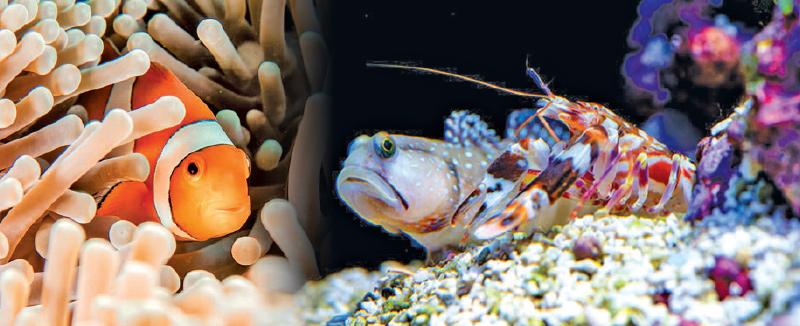
In the overcrowded tumult of life on the coral reef, living in close proximity with others is inevitable. Some animals have taken the close association one step further, evolving relationships with members of a quite different species.

Although such teamwork is usually to the mutual benefit of both parties, the participants are not actively or intentionally ‘cooperating’, instead it is a system that runs on instinct and selective advantages, not intelligence or idealism.
In the sandy bottom adjacent to the reef, a small shrimp works furiously to excavate a burrow which, on completion, is promptly taken over by a cream-coloured goby (Smilogobious).
Efforts
The goby, reluctant to leave its new home, remains on sentry duty at the entrance, snapping up odd morsels exposed by the shrimp’s efforts. The shrimp continues to put in hard physical labour, diligently maintaining the shared burrow. It is clear that the goby benefits, but at first sight there seems to be no advantage to the shrimp in allowing the intruder to stay.

On closer observation, however, it becomes obvious that the shrimp is virtually blind, and that the goby with its bulbous eyes, scans the area for predators. The shrimp, which trails an antenna over the back of its bodyguard, senses danger through the movement of the fish. Faced with a threat, both disappear into their joint bolt hole in an instant.
Even less likely relationships have evolved between fish and giant stinging anemones. On the Great Barrier Reef alone, 29 species of fish convene with 13 different species of anemone.
The tangled tentacles of sea anemones are endowed with sprung, poisonous barbs that fire on contact, injecting toxin into any creature unwary enough to stray into their deadly caress.
Yet the little clownfish (Amphiprion species) and others enjoy apparent immunity, passing unharmed through the lethal thicket, and sinking deep into an anemone’s tentacles if danger threatens.
The tiny clownfish, typically yellow, orange or red with white bands, have to work for their privileged position safe within the arms of the anemone.
Anemones secrete a special slime for protection. This is a substance that stops the stinging cells on one tentacle from discharging when they come in contact with other tentacles or the anemone’s body. Rather than acting as a bullet-proof vest, and deflecting the stings, the slimy mucus prevents them from firing at all.
Clownfish
Dicing with death, a clownfish must endure fleeting encounters with an anemone, deftly brushing against a tentacle or two, until it has acquired enough slime to coat its surface and trick the anemone into accepting the fish as a part of itself.
By sheltering amid the hundreds of tentacles, a fish is protected from predators.
It is not certain what, if anything, it offers in return for its safe haven, but it may drop morsels of food that the anemone picks up, and defend its anemone territory from butterfly fish (Chaetodon species) which bite at the tentacles, seemingly indifferent to the stinging cells. Clownfish have even been seen apparently tempting predators with bold displays in order to lure them into the mass of stinging tentacles where they become an easy meal for the anemone.
Most clownfish stay with the same anemone for their entire life, never straying more than a few feet away in order to feed, and they also lay their eggs at the base of the anemone for safety.
Several species of shrimp also live in association with anemones. Many of them, such as the banded Periclimenes species, find morsels of food in their anemone partner, and also provide a beneficial cleaning ‘service’, removing with their tweeser like pincers, wedged particles that the anemone cannot dislodge for itself.
The service is often extended to other willing recipients, be they fish or human divers. As it clambers over a fish, the shrimp removes parasites, mucus and loose scales, and cleans wounds sometimes actually cutting into the skin to remove infected areas.
Most of the detritus can be used as food, so the shrimp’s ‘motives’ are not altruistic ones, but it aids the larger animal, nonetheless, and the shrimp probably enjoys some protection from predators by the company it keeps.
The shrimps are among a number of animals that make their living from grooming others. Several species of fish, typically, small, slender, brightly coloured animals, are also in the cleaning business. They include the cleaner wrasse (Labroides) of the Indian and Pacific oceans and the neon gobies (Gobiosoma) of the Caribbean.
Attack
Like shrimps, they usually have a distinctive pattern of stripes that may well protect them from attack by their larger companions. Although the stripes no doubt evolved for this purpose, they now double as an advertisement to attract customers. Cleaner fish usually establish cleaning stations at prominent coral protuberances. The patrons do not usually need much persuasion. Large fish of all kinds such as, goat-fish, parrotfish, groupers, moray eels and jackfish, who are all evidently uncomfortable with their burden of parasites, gather at the station to wait their turn.
Predators
The tiny cleaners work over the body of each impassive client, picking of clinging parasites, meticulously removing pieces of damaged skin. This way, they also obtain a meal in the process. Despite darting provocatively inside the mouth and between the sensitive gills of large predators, the cleaners are almost never eaten while undertaking their risky job.
The cleaning service is clearly an invaluable one: some large fish apparently spend about as much time being cleaned as they spend looking for food. In the West Indies, when the cleaner species were experimentally removed from a reef, many fish left the region. Those that remained became unhealthy with sore and tattered fins.
One animal cheats the system. The saber-toothed blenny (Aspidontus taeniatus) imitates both the colour patterns of the cleaner wrasse and its characteristic jerky movements. As trusting fish allow the fraud to approach, it leaps forward, and instead of removing parasites, takes a chunk of flesh from a fin or a gill.
